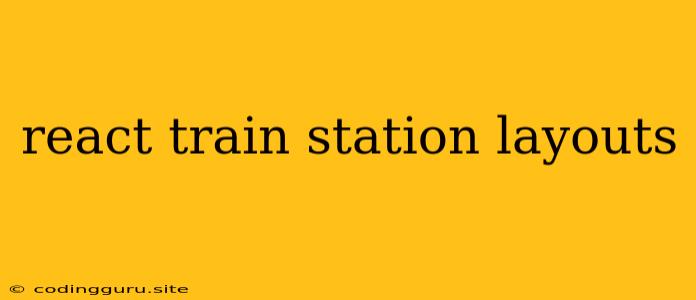Designing a React Train Station Layout: A Comprehensive Guide
Creating a visually appealing and user-friendly React train station layout can be a challenging task. This guide aims to help you navigate the process, providing insights and techniques to craft an exceptional user experience.
Why React for Train Station Layouts?
React's component-based architecture makes it ideal for developing complex and interactive layouts, particularly for train stations. Its ability to manage state efficiently and re-render only the necessary components ensures smooth performance, even with large amounts of data.
Planning the Layout
Before diving into code, carefully plan the layout structure. Consider these key aspects:
- Data Sources: How will you obtain and manage train schedule data?
- User Needs: What information do passengers typically seek (platform details, departure times, real-time updates)?
- Visual Hierarchy: What elements should be emphasized (platform maps, arrival/departure boards)?
- Accessibility: Ensure the layout is accessible to users with disabilities (e.g., color contrast, keyboard navigation).
Designing the User Interface
1. Platform Maps:
- Interactive Maps: Use React libraries like Leaflet or Mapbox GL JS to create dynamic and interactive platform maps.
- Legend & Icons: Provide a clear legend explaining the meaning of different colors, shapes, and icons.
- Zoom & Pan: Allow users to zoom and pan the map to view specific areas.
2. Arrival/Departure Boards:
- Real-Time Updates: Fetch real-time train data using APIs or websockets to display accurate departure/arrival times.
- Filtering Options: Enable filtering by train type, destination, or time.
- Visual Cues: Use color coding or other visual cues to highlight delays or cancellations.
3. Train Information:
- Details on Demand: When a user selects a specific train, display details like platform, track number, and estimated time of arrival/departure.
- Accessibility Features: Ensure text size and contrast are adequate for accessibility.
4. Navigation & Search:
- Intuitive Navigation: Use clear labels and consistent navigation patterns (e.g., tabs, dropdown menus).
- Search Functionality: Implement a search bar to allow users to find specific trains or destinations.
5. Additional Features:
- Ticket Purchase: Integrate with ticketing systems to allow users to purchase tickets directly.
- Route Planner: Provide a route planner that suggests the best routes based on the user's origin and destination.
- Push Notifications: Offer optional push notifications to alert users of train delays or cancellations.
Implementation Tips:
- State Management: For complex data and interactions, consider a state management library like Redux or Zustand.
- Component Reusability: Break down the layout into smaller, reusable components for maintainability and code organization.
- Testing: Implement thorough unit and integration tests to ensure the layout functions correctly and handles various scenarios.
Example React Components:
// PlatformMap.js
import React, { useState, useEffect } from 'react';
import { MapContainer, TileLayer, Marker, Popup } from 'react-leaflet';
const PlatformMap = ({ platforms }) => {
const [center, setCenter] = useState([51.505, -0.09]);
useEffect(() => {
// Logic to determine the center of the map based on platform data
}, [platforms]);
return (
{platform.name}
))}
);
};
export default PlatformMap;
// TrainSchedule.js
import React, { useState, useEffect } from 'react';
const TrainSchedule = ({ trainData }) => {
const [filteredData, setFilteredData] = useState(trainData);
const handleFilterChange = (event) => {
// Filtering logic based on user input
};
return (
{/* Filtering controls */}
Train
Destination
Departure Time
{filteredData.map((train) => (
{train.name}
{train.destination}
{train.departureTime}
))}
);
};
export default TrainSchedule;
Conclusion:
Crafting a React train station layout involves careful planning, design, and implementation. By using the strategies outlined in this guide, you can create a visually appealing, user-friendly, and informative layout that enhances passenger experience. Remember to focus on clarity, accessibility, and real-time updates to make your train station layout truly exceptional.
